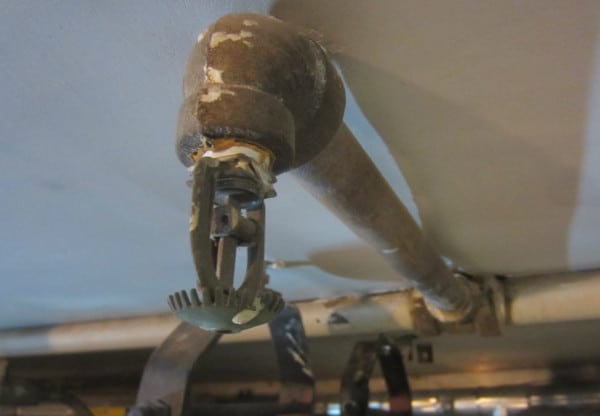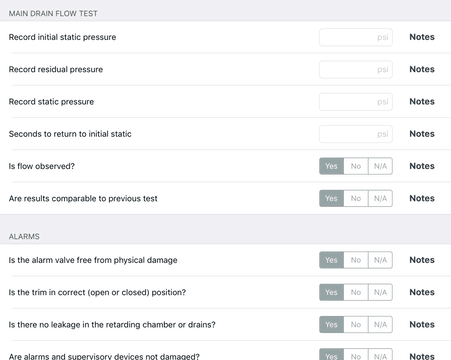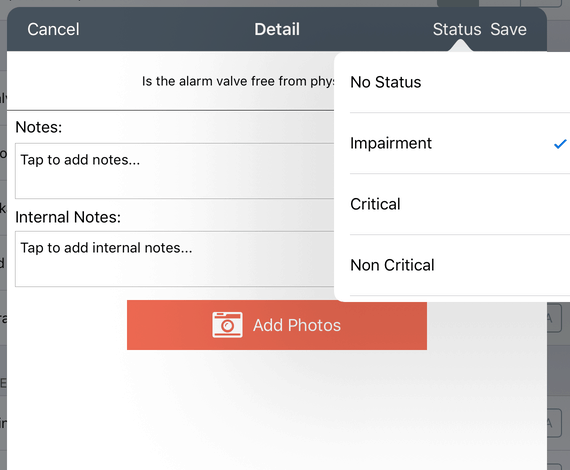Fire protection inspection software improves compliance, safety, and profits
Some 3,400 people died in fires in 2017—the most recent reported numbers and the highest number of fatalities in the past decade. A life safety inspection, testing, and maintenance (ITM) company’s role in uncovering and correcting deficiencies in fire protection systems is more than a job—it’s essential for public safety. And life safety inspection software—including standpipe, alarm, fire extinguisher, and fire sprinkler inspection software—can make the process far easier and more effective.
The cumbersome steps that accompany paper-and-clipboard inspections sometimes mean a lot of time elapses between discovering an impairment and fixing it. This gap may threaten the safety of building occupants, cut into an ITM company’s ROI, and give competitors the chance to win the business.
In this blog, we show how digital inspection tools are improving and speeding the process for following up on and correcting deficiencies uncovered during ITM inspections.
If you’d like to see how fire inspection software works and how it make inspections, maintenance, reports, scheduling, and correcting deficiencies more efficient, sign up for a free demo of Inspect Point’s fire protection ITM software.
Deficiencies and impairments: the fire-code clock is ticking
Regular inspections of fire protection equipment are a critical component of any building’s safety and ROI. Inspections are investments that build upon each other, a proactive force that means fewer costly problems and that the systems designed to protect people and property from fire will work when they’re needed most.
ITM professionals follow the National Fire Protection Association (NFPA) standards that detail minimum requirements for the inspection, testing, and maintenance of fire protection systems, from fire sprinklers and standpipes to alarms and hydrants. NFPA also outlines the process that needs to be followed when problems are found, including proper fixes and reporting. Local authorities having jurisdiction (AHJs) often build upon these guidelines with specific requirements for their areas based on the model fire codes and standards.
The local AHJ reviews the ITM contractor’s report and enforces necessary repairs being completed. Many jurisdictions also have their own requirements for the timely correction of impairments and/or deficiencies. But it’s up to the contractor and the building owner to complete them in a timely manner.
Exploring and repairing the root causes of any issues that are discovered is not only critical for reliable performance—but a key source of revenue for an ITM business. And failing to quickly correct these deficiencies can carry major consequences for property owners, including fines, legal liabilities, increased insurance rates, and unpaid insurance claims.

One of the key ITM standards, NFPA 25: Standard for the Inspection, Testing, and Maintenance of Water-Based Fire Protection Systems, categorizes components that aren’t up to code into three categories to help prioritize repairs: impairments, critical deficiencies, and noncritical deficiencies.
- Noncritical deficiencies don’t impact system performance but must be corrected to meet NFPA standards within a reasonable amount of time (3.7.2). They might include missing signs or an inadequate number of spare sprinklers.
- Critical deficiencies – perhaps suspiciously painted sprinklers or inaccessible fire hydrants — can have a “material impact” on system performance and should be corrected as soon possible (3.7.1).
- Impairments are the most serious, meaning all or part of the system is out of order and won’t function properly until it’s repaired – whether the impairment was preplanned for system work or is caused by an emergency like frozen pipes (3.21). Impairments are the highest priority and must be addressed immediately.
From the 2017 edition of NFPA 25
A.3.3.7 An impairment should be addressed promptly by either immediately correcting the condition or implementing the impairment procedures found in Chapter 15. Critical and noncritical deficiencies should be corrected as soon as practical after considering the nature and severity of the risk.
NFPA 25 (A.4.1.5.1) also urges inspectors to focus on deficiencies not explained by normal wear and tear. Unexplained deficiencies—such as banging noises in the sprinkler piping or perplexing leakage at closed nipples—could be symptoms of a greater problem that “could lead to catastrophic failure,” the standard warns.

How clipboards and paper hurt fire safety inspection companies’ ROI—and may even put people and property at risk
For an ITM business, here’s where the problem kicks in:
Say an ITM technician averages four inspections a day. Each traditional clipboard-and-paper inspection may generate at least an hour of paperwork back at the office, by the time the report is reviewed, processed, and filed, and a corrective plan is written. Even low-tech digital improvements such as inspection documents that are PDF, Excel, or Word files don’t do much to improve efficiency with no way to quickly transform the data into a proposal.
Given that many ITM companies average 4 or 5 technicians performing inspections, paperwork can quickly accumulate. Traditionally, it takes days and even weeks for contractors to generate and deliver proposals to fix the issues their inspections uncovered, followed by getting sign-off from the building owner or representative to actually fix the problem.
That doesn’t include the time inspectors spent tediously writing information on paper during the inspection, and perhaps taking a separate picture with a phone that must be inserted into the final report. Or attempting to uncover a trend that signifies deteriorating equipment by searching files for previous reports, which can easily be misplaced, lost, or ruined when they are stored as paper copies or as a PDF on a hard drive.
Every day that passes before a critical deficiency or impairment is fixed creates potential life safety risks for the building and can put property owners afoul of NFPA and local fire code timelines. In addition, taking too long to send a proposal may spur nervous property owners to seek other businesses to repair the problem.

Responsiveness is key in sales, and for an ITM business, it’s vital to maximizing ROI by turning the deficiencies that need to be addressed into new business. This also reduces the delay in fixing deficiencies and impairments that impact compliance and life safety: the faster a proposal is delivered to a customer, the more likely it is to be signed—and for the problem to be fixed.
As much as 50 percent of sales go to the vendor that responds first, according to sales consulting firm The Brevet Group. Winning proposals are delivered to customers 26 percent faster—with the average losing proposal taking 3.4 days to arrive.
Even if the proposal is turned around within a few days, projects stall when customers who have moved on to other priorities drag their feet in granting authorization. Too much of an ITM business’s day can be wasted chasing property owners for the signature that’s required to begin repairs—and sometimes, work is lost after the contractor gives up on reaching the customer after a few tries. Once permission is finally granted, it’s still not time for work to begin. More time is spent back at the office ordering parts and scheduling technicians to return and make the corrections.
Paper inspections lead to other issues as well. When time means money, contractors generally don’t have a lot of time to look at every piece of information on every old document—or, more importantly, to put those pieces of information together—and that makes it too easy for subtly downward performance or compliance trends to be overlooked. Revenue is also easily lost when a distracted technician forgets to note an issue during the inspection, so it’s omitted from the repair proposal.
At the end of the day, an inefficient paper process generates higher labor costs, higher administrative costs, bigger risks, and less earned business—leading to a worse outcome for every business owner: lost revenue and significantly lower ROI.

Why ditching paper and using standpipe, alarm, fire extinguisher, and fire sprinkler inspection software means better compliance and profits
Just like the methodical evolution of model codes and standards, the fire protection industry is sometimes slow to embrace new technologies that change the way work has always been done. But digital inspection software is now dramatically improving the way that inspections impact building safety for customers, while increasing revenue for the ITM contractor.
All primary NFPA codes now permit electronic inspection reporting, including NFPA 25:
From the 2017 edition of NFPA 25
4.3.1.1* Records shall be permitted to be stored and accessed electronically.
Adopting Inspect Point’s ITM software vastly increases efficiency and compliance—enabling quicker, better inspections, testing, and maintenance of fire protection systems with higher ROI. Its 100 percent digital interface simplifies onsite ITM and automates back-office activities that enable contractors to do their jobs more efficiently. Faster inspections and service follow-ups mean more of both for a wider range of clients, increasing revenue while the software improves thoroughness and quality.
New technology can be intimidating but operating Inspect Point is simple for any technician familiar with using a cell phone or mobile tablet. The software is user-friendly and compatible with iPads and mobile devices.
The intuitive iPad application puts a property’s ITM history at inspectors’ fingertips, making it easy to spot trends and flagging equipment that has suffered previous deficiencies. The software is preloaded with all the questions and NFPA codes and standards a technician needs to inspect fire protection equipment, including sprinklers, standpipes, alarms, hydrants, extinguishers, and fire pumps. The program can also be customized to ensure compliance with local laws and to decrease inspection time by eliminating ITM items that aren’t relevant to the current frequency, system, asset, and building requirements.
Inspect Point provides a step-by-step inspection process every time technicians are in the field, requiring them to check off each step to make sure no detail goes unnoticed.
Watch this video to learn more about the benefits of this digital inspection tool:
But one of the most compelling advantages of Inspect Point is its ability to earn more business for an ITM contractor on the spot after deficiencies are documented. Let’s reconsider the traditional steps for following up on and correcting problems discovered during an inspection.
Create branded service reports as soon as inspections are finished
With Inspect Point, it only takes a click for technicians to generate inspection reports. These are branded with their company’s logo and automatically populated with information inputted during the inspection and the deficiencies documented with the iPad camera. Technicians can also securely sync with back-office teams without ever leaving the job site—sending inspections, photos, notes, signatures, deficiencies, and proposed corrections in real-time via a single, easy-to-read document.
That means no more lengthy delays while the back office waits for paper inspections to arrive at the end of the day, struggles to decipher handwriting, attaches and associates deficiency images, and generates final inspection reports.
There is no need for thumb drives to upload files, scanning, photocopying, or combining images and handwritten reports into electronic documents. There’s no lost time while technicians race back to the office to grab additional paper templates for inspections. And with photos and notes automatically transferred into the report—and settings that require elements to be completed—there’s little chance that something important will be omitted.
Generate new business by delivering proposals and scheduling service calls while inspectors are onsite
Inspect Point seamlessly links the business’s technicians and back office. Work no longer has to stall while administrators compile paperwork or schedules, deliver proposals, and then wait for clients to respond.
Instead, contractors can prepare and present proposals immediately after work is complete instead of days later—giving them the opportunity to get signatures and schedule follow-up service to address deficiencies while they are still in front of the client. Back-office teams can start ordering parts and assigning service technicians within minutes of receiving approval on proposals.
Instantly create fire pump performance curves
Plotting fire pump performance curves ranks among the most time-consuming tasks for life safety inspectors. Inspect Point speeds this process by inserting the readings technicians collect in the field into a professional, computer-generated graph inside the program. It plots each point of the curve and attaches it to the final inspection report, vastly reducing the chance of human error and making it easy to determine if a fire pump is degrading.

Clearly prioritize the most critical deficiencies and impairments
After technicians document deficiencies with the iPad camera, they can select a deficiency status based on NFPA’s classifications that assist with workflow and service follow-up. This detail helps the back office prioritize strategic service dispatch and ordering decisions and will assist in getting onsite signatures from building owners and their representatives for work that must be completed ASAP.

Digital ITM software gives fire safety inspectors an unprecedented opportunity to speed follow-up and repairs
Fire protection systems can suffer any number of deficiencies or impairments, from worn-out parts to corroded pipes to obstructions in the water supply. The inefficient process for correcting them that goes hand-in-hand with clipboard-and-paper inspections—or even ones completed with PDFs that don’t automatically generate reports and proposals—significantly reduces life safety compliance and an ITM contractor’s ROI.
Digital inspection tools like Inspect Point are transforming the ITM industry, giving contractors an unprecedented ability to speed the follow-up process from days or weeks to hours—increasing revenue and taking fire protection to a new level of safety and reliability.
Schedule a free demo of Inspect Point’s fire protection ITM software.
For more information about Inspect Point or QRFS products, call us at +1 (888) 361-6662 or email support@qrfs.com.
This blog was originally posted at blog.qrfs.com. Check us out at Facebook.com/QuickResponseFireSupply or on Twitter @QuickResponseFS.



New startup in a month as soon as state processes my business paperwork, looking for IPAD based software to eliminate printing paper, also for storage solution for previous inspection.
James — If your inspections are related to fire protection systems, Inspect Point is a potential solution. But it is designed for detailed fire protection system inspection, testing, and maintenance, so it may be something that you recommend that your fire protection contractor uses, if applicable.
We are looking for a software for our company for Fire Equipment & Alarm Sales, Service, Repairs.
Khyati – Inspect Point is a great scheduling and inspection, testing, and maintenance compliance solution for ITM companies servicing fire alarms per NFPA standards. Just click this link to schedule a free demo of the software.